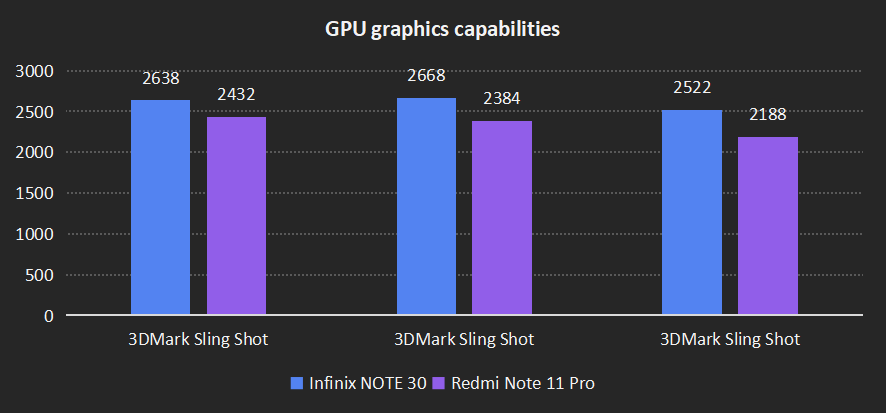
The mobile gaming industry has witnessed remarkable growth in recent years, evident from the immense popularity of hit games like “Free Fire” and “Arena of Valor.” Gamers now prioritize gaming performance, fast charging, and battery life when choosing a mobile phone. In this regard, Infinix NOTE 30 and Redmi NOTE 11 Pro stand out as top contenders for providing exceptional value within their price range. These models have become symbols of great affordability, but only one can claim the title of the ultimate cost-effective champion.
Table of Contents
Competitor performance comparisons
When evaluating mobile phone performance, two crucial factors come into play: the phone’s SoC chip and the manufacturer’s system tuning. In the case of the Infinix NOTE 30 and Redmi Note 11 Pro, the former takes the lead in terms of SoC chip. The Infinix NOTE 30 boasts a MediaTek Helio G99 processor, which is a step ahead of the Helio G96 processor found in the Redmi Note 11 Pro. With a more advanced 6nm process and improved heat control, the G99 processor offers superior performance.

Benchmarking software like GeekBench and GFXBench further confirm the Infinix NOTE 30’s superiority. It achieves a single-core score of 549, surpassing the 512 score of the Redmi Note 11 Pro. In multi-core performance, the Infinix NOTE 30 scores 1802, outperforming the Redmi Note 11 Pro’s 1743 score. These results solidify the Infinix NOTE 30’s dominance in terms of CPU performance.

Turning to GPU graphics capabilities, which directly impact gaming performance, the Infinix NOTE 30 excels. According to 3D MARK scores, it consistently achieves scores 200-300 points higher than the Redmi Note 11 Pro. This means users can enjoy a more stable frame rate when playing 3D games on the Infinix NOTE 30.
When considering RAM capacity, both phones support memory fusion expansion technology. However, the Infinix NOTE 30 takes the lead once again. While the Redmi Note 11 Pro can expand up to “8G+3G=11G,” the Infinix NOTE 30 offers greater expansion capabilities of “8G+8G=16G.” This translates to faster loading speeds and the ability to run more resident apps during gameplay.
In summary, the Infinix NOTE 30 excels in both CPU and GPU performance, offering a superior gaming experience and greater RAM expansion capabilities compared to the Redmi Note 11 Pro.
Fast charging and battery life comparisons
Both the Infinix NOTE 30 and Redmi Note 11 Pro come equipped with a sizable 5000mAh battery, providing comparable endurance during a 5-hour power consumption test. In this test, which included activities like Facebook, YouTube, PUBG gaming, TikTok, calls, and video shooting, both phones displayed similar performance, with the Infinix NOTE 30 retaining 30% battery power and the Redmi Note 11 Pro showing 31%.

When it comes to charging capabilities, the Infinix NOTE 30 offers 45W fast charging, while the Redmi Note 11 Pro boasts 67W fast charging on paper. However, actual tests revealed that the initial charging speed of both phones was nearly identical. They both reached around 16% in 5 minutes and approximately 29-30% in 10 minutes. In terms of full battery charge time, the Infinix NOTE 30 outperforms the Redmi Note 11 Pro, taking 52 minutes to charge from 0% to 100%, while the latter requires 55 minutes for a complete charge. Based on these findings, we can confidently say that the charging capabilities of the two phones are quite similar.

In-game Experience Comparisons
To better evaluate the performance and thermal control of the Infinix NOTE 30 and Redmi Note 11 Pro, actual testing was conducted while running the game “PUBG Mobile” with identical settings. The Infinix NOTE 30 delivered a lag-free experience with a consistently smooth average frame rate close to 40 frames. On the other hand, the Redmi Note 11 Pro exhibited stable frame behavior but occasional screen shaking when the frame rate settled around 30 frames. The frame rate switching process also caused slight discomfort with this model.


The Infinix NOTE 30, equipped with the 6nm chip G99, demonstrated superior thermal control. This can be attributed to its innovative bypass charging function, a popular feature in gaming phones. By directing power directly to the motherboard instead of the battery, this function achieves a maximum thermal efficiency of 7°C. Not only does it extend battery life, but it also reduces heat generation while charging and playing. Undoubtedly, the bypass charging function adds significant value to the phone.
While the Redmi brand has been synonymous with “extreme cost-effectiveness,” it’s clear that Infinix, the rising star in the industry, is making a strong claim to this title. With a more powerful chip, ample memory, and the benefits of bypass charging’s low heat characteristics, the gaming performance of the Infinix NOTE 30 is undeniably outstanding. Furthermore, considering the price point, the Redmi Note 11 Pro 128+8GB is priced at ₦180,000 while the Infinix NOTE 30 128+8GB offers exceptional value at a lower price of ₦120,900 representing a 39% reduction compared to the former. For users seeking high gaming performance, the Infinix NOTE 30 confidently earns the title of the true king of cost-effectiveness.

One thought on “Choosing the Best Bang for Your Buck: Infinix NOTE 30 vs Redmi NOTE 11 Pro”